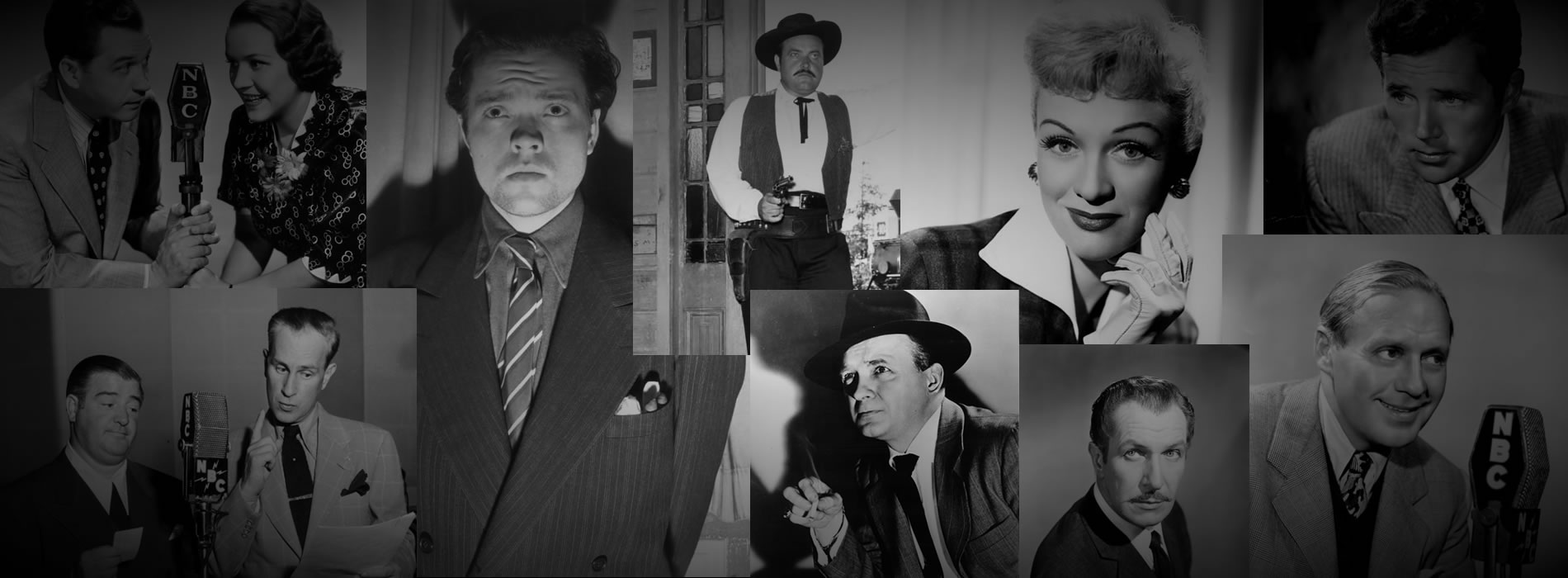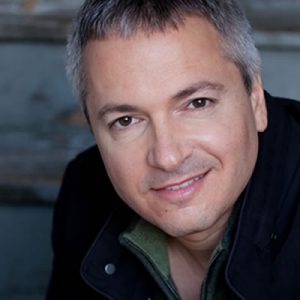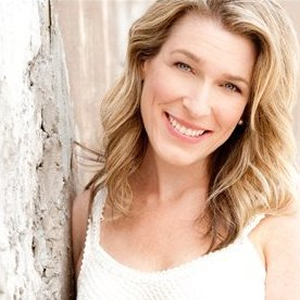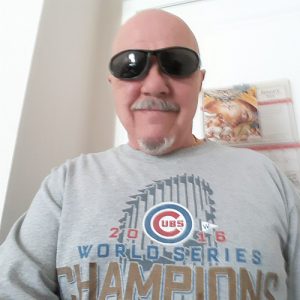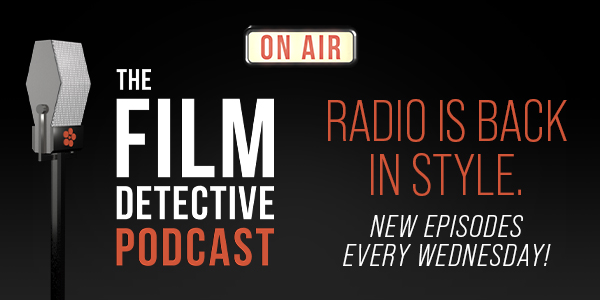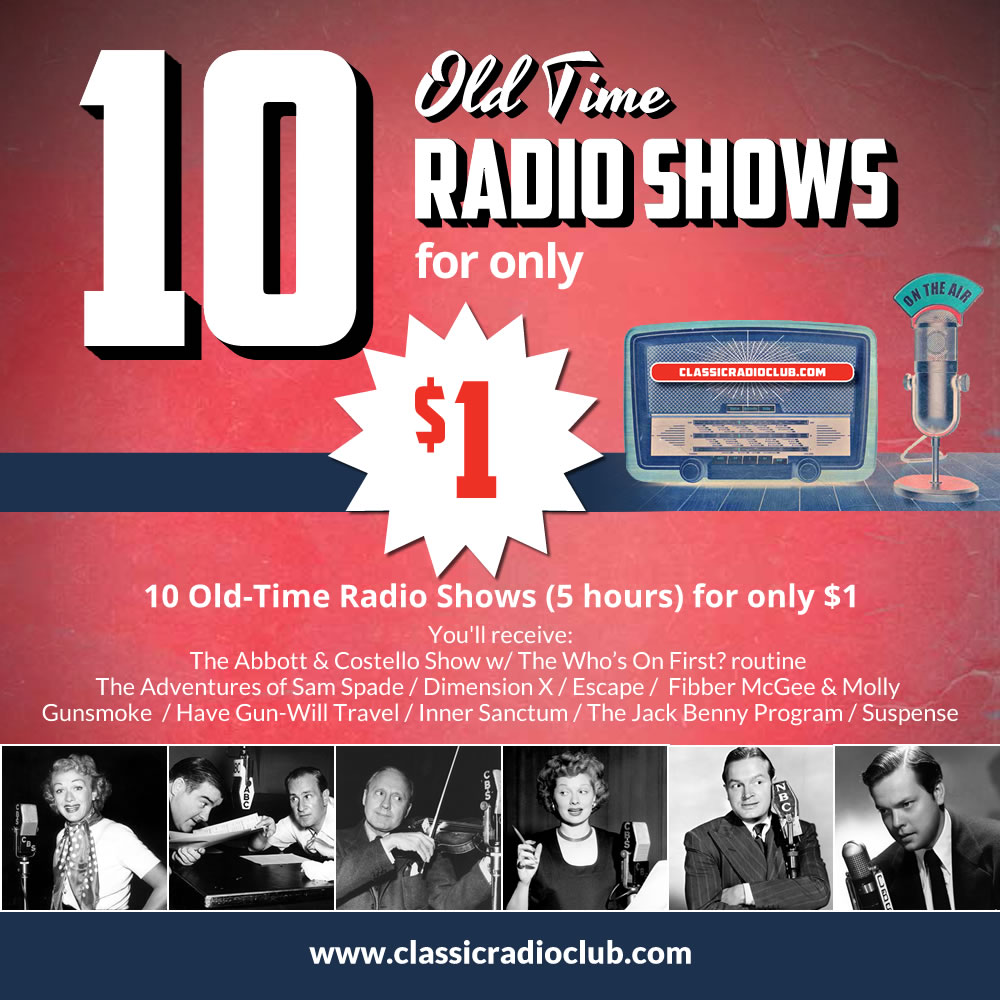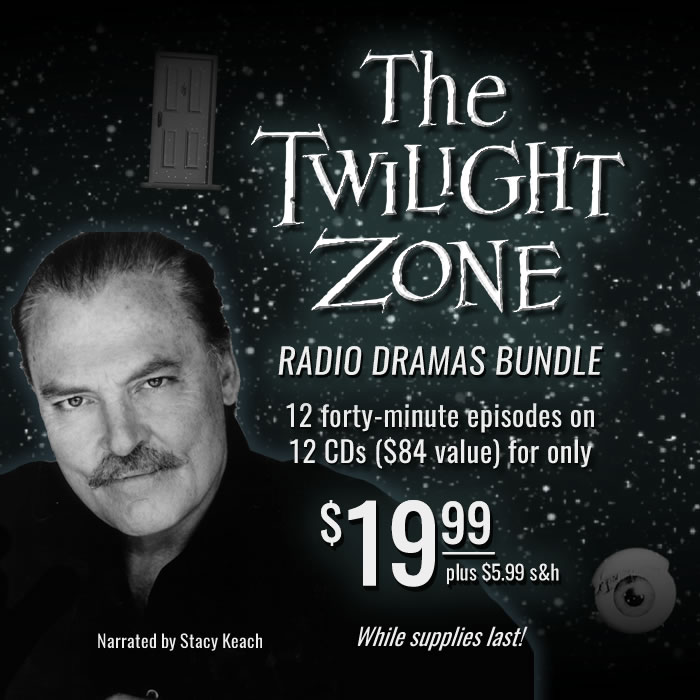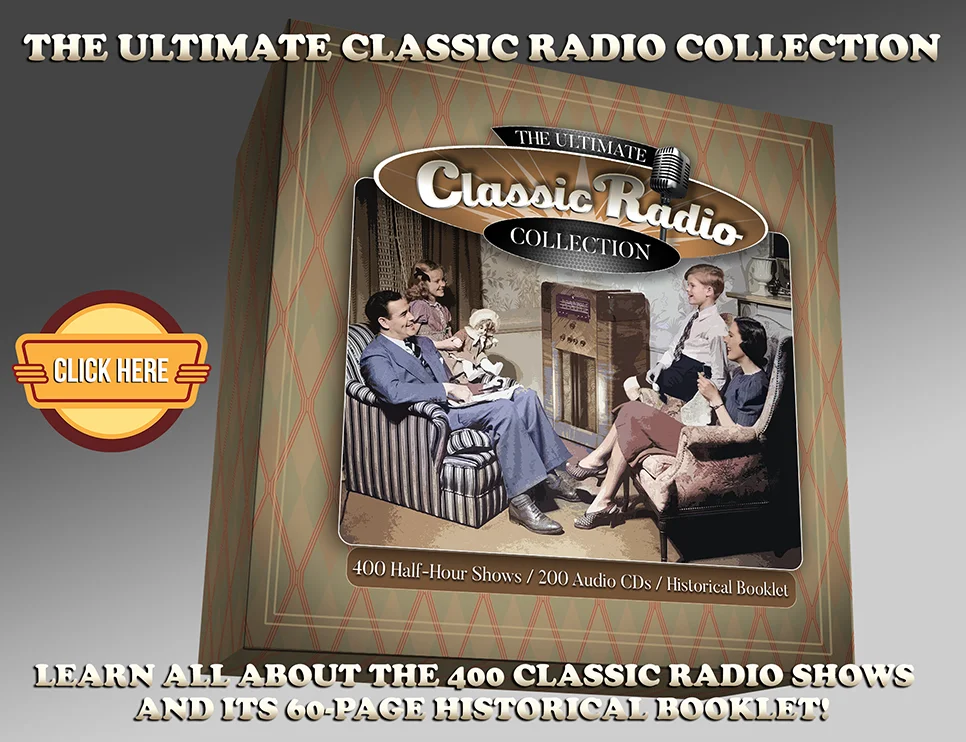
NEWSLETTER | VOL. 8, DECEMBER 2021
Welcome to this month’s edition of The Hollywood 360 Newsletter, your place to get all the news on upcoming shows, schedule and interesting facts from your H360 team!
Carl’s Corner
by Carl Amari
Hello everyone – here’s the Hollywood 360 Newsletter, December 2021 Vol. 8. As someone on our mailing list, you’ll receive the most current newsletter via email on the first day of every month. If you don’t receive it by the end of the first day of the month, check your spam folder as they often end up there. If it is not in your regular email box or in your spam folder, contact me at carlpamari@gmail.com and I’ll forward you a copy. The monthly Hollywood 360 newsletter contains articles from my team and the full month’s detailed schedule of classic radio shows that we will be airing on Hollywood 360. Each month I’ll write an article on one of the classic radio shows we’ll present on Hollywood 360. The week of December 20th, 2021 we’ll be airing an episode of THE BURNS & ALLEN SHOW so here’s an article on this incredible comedy series. FYI: I was good pals with George Burns. He licensed me his radio series and provided a foreword for a book I wrote years ago. He used to take me to his country club in Beverly Hills where we’d have lunch and talk for hours about Gracie and their long career and life together. Here’s a picture of me and George in his Hollywood office circa 1992 (the cup on the table had GOD printed on it).
THE BURNS & ALLEN SHOW
by Carl Amari
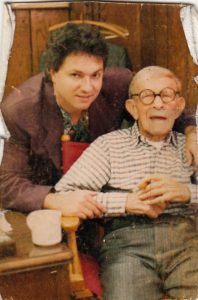 When real-life husband and wife George Burns and Gracie Allen started performing vaudeville together in the late 1920s, George was the comic and his wife Gracie had the straight lines. They switched their roles upon discovering that Gracie’s delivery got a bigger laugh than George’s punch lines.
When real-life husband and wife George Burns and Gracie Allen started performing vaudeville together in the late 1920s, George was the comic and his wife Gracie had the straight lines. They switched their roles upon discovering that Gracie’s delivery got a bigger laugh than George’s punch lines.
The duo became a big hit on vaudeville and in film, so when radio beckoned, they delivered for NBC. Millions of listeners believed Gracie was as dumb as she sounded – a tribute to both her comic brilliance and the crackling scripts.
For a long time they continued a ‘flirtation act’ with George as Gracie’s most persistent suitor. But when the show’s ratings began to sag toward the end of the ‘30s, George decided it was time their real-life marriage was written into the show. The new format included husband-and-wife characters in a situation-comedy setting. George’s instincts were spot-on and The Burns & Allen Show soared to new heights.
In 1942, Gracie decided to run for President, a fictitious campaign designed as a major publicity stunt for the radio program. Many Americans welcomed Gracie’s preposterous slogans and promises. Spoiler alert: She didn’t win but the gimmick worked, adding legions of fans to the show. Celebrity guests were added to the mix: Barbara Stanwyck and Gracie cleaned house together; Lana Turner helped George acquire sex appeal so he could get elected as a councilman; and when the Beverly Hills Uplift Society planned a charity auction, they donated Brian Aherne’s boxer shorts.
Ever the businessman, Burns left NBC in 1949 and signed a lucrative contract with CBS that included television. Gracie was hesitant at first but quickly discovered she was a pro in front of the camera. On TV, George broke the “fourth wall” and spoke directly to the audience while Gracie continued to play dumb.
In 1958, after three decades working together, Gracie retired and George continued to work headlining in nightclubs. In 1975, at the age of 79, George had a career revival as co-star of the 1975 film The Sunshine Boys, for which he won the Academy Award for Best Supporting Actor. He played God in the Oh God! film trilogy and continued to stay active until his passing in 1996 at the age of 100.
LEND ME YOUR EARS | THIS MONTH’S SONG: THE CHAIN, BY FLEETWOOD MAC RELEASED: 1977
by Lisa Wolf
“Originally we had no words to it. And it really only became a song when Stevie wrote some. She walked in one day and said, ‘I’ve written some words that might be good for that thing you were doing in the studio the other day.’ But it ultimately becomes a band thing anyway, because we all have so much of our own individual style, our own stamp that makes the sound of Fleetwood Mac.” ~ Mick Fleetwood
“The Chain” is a song by the rock band Fleetwood Mac, released on their critically acclaimed, best-selling album Rumours. It is the only song from the album credited to all five members (Stevie Nicks, Lindsey Buckingham, Christine McVie, John McVie, and Mick Fleetwood).
“The Chain” did not follow the normal procedure of songwriting and recording. Rather, it was put together by combining various separate tracks which some of the band members did on their own. According to Lindsey Buckingham, that is the reason the for song’s name – like a chain it “was a bunch of pieces” linked together.
The song originally represented the internal fractures of the band members, but eventually came to symbolize their triumph in staying together. Rumours is one of the bestselling albums ever recorded, and in addition to being inducted into the Rock and Roll Hall of Fame, the band has earned a star on the Hollywood Walk of Fame.
“The Chain” appeared on Marvel Studios’s film Guardians of the Galaxy Vol. 2 and in the film I, Tonya.
Vince’s Verbiage: The 1960s
by Carl’s Crabby Brother Vince
Let me start out by wishing everyone a very Happy Holiday season and a very Happy New Year. The great Victorian novelist Charles Dickens (1812-1870) once wrote “These are the best of times, these are the worst of times.” To me, that sums up the decade of the 1960’s. There were many good things that happened and many bad things. The Beatles arrived in the U.S.A. in 1964 and not only brought a new style of music with them but they also had a HUGE influence in the way we wore our hair, the way we dressed and the way we danced. The Beatles seemed to change our culture altogether. They also ushered in many other great rock bands, including The Rolling Stones, The Dave Clark Five, The Animals, and The Kinks.
But the year before that, 1963 saw the assassination of President John F. Kennedy on November 22nd. A low point in American history. But 1963 wasn’t totally bad. We saw the passage of the Equal Pay Act for Women which was long overdue and the less impactful push button telephone was introduced. Then on the night of July 13th and early morning hours of July 14th 1966 a grizzly crime was committed in Chicago. Eight student nurses were viciously murdered by a drug and alcohol addicted monster named Richard Speck. This crime horrified the city and the nation. People made sure their doors and windows were locked at night after that happened. 1968 saw the assassinations of two other leaders. Martin Luther King Jr. on April 4th and Robert F. Kennedy on June 5th. The King assassination sparked 48 hours of rioting in Chicago that left 11 citizens dead, 48 wounded by police gunfire, 90 police officers injured and 2,150 people arrested. But if that wasn’t bad enough, the Democratic National Convention in Chicago started on August 26th 1968. Riots broke out again. This time over civil rights, the continued war in Vietnam and our youth wanting to change the voting age from 21 to 18. Nobody was killed during these riots but over 500 protesters, over 100 other citizens and 152 police were injured.
Then on July 20th 1969 America truly made history when Apollo 11 set down on the lunar surface and astronaut Neil Armstrong climbed down the ladder to become the first human being to ever step foot on the moon. A little less than a month later on August 15th 1969 over 400,000 people arrived at Max Yasgur’s dairy farm in Bethel, New York (40 miles southwest of the town of Woodstock) for a music festival that lasted almost four days and has since been called “a rock concert for the ages”. The Woodstock festival introduced millions of Americans to some outstanding rock bands like The Who, Santana, Jefferson Airplane, one of my favorites, Joe Cocker and many others. At the time, it was called the largest gathering of humanity in one place in the history of the world. Since then I think the Cubs parade after their 2016 World Series victory surpassed that number with what some people estimate at over 5 million people lined up along the parade route. Speaking of the Cubs, the 1960’s started out pretty miserable with losing season after losing season. Then came the second half of the 1960’s when the Cubs started to get better and better. Then by 1969 they were the favorites to “WIN IT ALL”. For five months they were the best team in all of baseball, but by September they nose dived like the submarine the Seaview from the 1964 TV show “Voyage to the Bottom of the Sea”. So even for the Cubs and their many fans 1969 was “the best of times and the worst of times”. Oh by the way, a few other good things happened in the 1960’s. My little brother Carl was born August 20th, 1963 and I even graduated grammar school in 1965 and high school in 1969 … ON TIME, which was a miracle!

Observations on the Obscure: THE HERMIT’S CAVE: Thrilling Audiences from Motown to Tinseltown
by Karl Schadow
In the spring of 1935, listeners to Detroit station WJR were introduced to a new character, The Hermit, as the narrator of the series of ghost stories which had been aired by the station for several years. The cave dweller joined WOR’s Ol’ Nancy (The Witch’s Tale) and KOIL’s The Phantom (Krime Klan) in an elite group of spooky, radio story tellers.
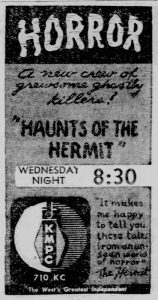 Known initially as In The Hermit’s Cave, the broadcasts were produced by Charles Penman, director of The Mummers in the Little Theater of the Air. This troupe had earned high acclaim for their previous dramatic performances on WJR. In order to adequately set the mood during the each of the weekly episodes, The Hermit would instruct his audience to: “Turn off your lights. Turn them off!” He would then outline the grisly tale and end the opening segment with a maniacal laugh. John Kent was the first actor holding the role. After a couple of years, he yielded the part to Klock Ryder.
Known initially as In The Hermit’s Cave, the broadcasts were produced by Charles Penman, director of The Mummers in the Little Theater of the Air. This troupe had earned high acclaim for their previous dramatic performances on WJR. In order to adequately set the mood during the each of the weekly episodes, The Hermit would instruct his audience to: “Turn off your lights. Turn them off!” He would then outline the grisly tale and end the opening segment with a maniacal laugh. John Kent was the first actor holding the role. After a couple of years, he yielded the part to Klock Ryder.
Also during the late 1930s, Charles Penman departed the series with the show’s former scribe Eric Howlett promoted to director. Geraldine Elliott, who would later become Mrs. Howlett signed on as the author. Her comments (Detroit Free Press, February 6, 1938) on the collaboration with the helmsman declared: “We try to write a story that we feel will give to the listening audience the best opportunity of visualizing the life of an abnormal individual. Dealing with supernatural things creates and stimulates imagination. We let our imaginations run wild.” The cast not only included WJR stalwarts Lillian Popkin and Jack Kessler, but also Paul Hughes and others heard on various WXYZ productions. The grisly sound effects were performed via a team headed by Sidney Brechner.
In September of 1937 ,WJR signed the Carter Coal Company (promoting Olga Coal) for what would result in a decade-long sponsorship of the Sunday night shocker. A coinciding event in the program’s history was the recording and syndication of broadcasts by Carter’s advertising agency, Ralph Jones Company based in Cincinnati. Transcriptions were distributed to stations throughout the Midwest and Mid-Atlantic regions including WBBM (Chicago). The Coal company continued its advertising campaign through 1947. At that time, Toby Grimmer was portraying The Hermit. The series returned for a thirteen-week term on WJR in January 1950 under the auspices of the Coal Heating Service of Greater Detroit. Approximately two dozen episodes of the WJR series are in circulation.
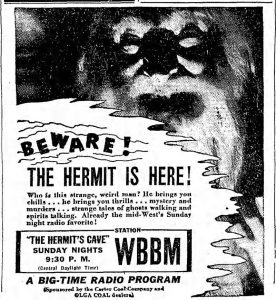 A second version of The Hermit’s Cave debuted September 8, 1940 on WJR’s sister station, KMPC (Beverly Hills). Previously aired scripts by Geraldine Elliott were sent west to assist in maintaining program consistency. New plots were crafted by West Coast authors Herbert R. Connor and Lou Huston, among others. Of special note is that one of these wordsmiths was Elliott Lewis. His first radio script “The Drain” was performed on this series.
A second version of The Hermit’s Cave debuted September 8, 1940 on WJR’s sister station, KMPC (Beverly Hills). Previously aired scripts by Geraldine Elliott were sent west to assist in maintaining program consistency. New plots were crafted by West Coast authors Herbert R. Connor and Lou Huston, among others. Of special note is that one of these wordsmiths was Elliott Lewis. His first radio script “The Drain” was performed on this series.
Another ‘first’ for the KMPC production involved actress Virginia Gregg (later of Gunsmoke, Yours Truly, Johnny Dollar, etc.) who proclaimed in an interview (Hollywood Citizen-News, August 10, 1949) that her initial role in a dramatic series occurred on The Hermit’s Cave. She applauded KMPC for providing newcomers a chance to enter the industry during the early 1940s. Other well-known West Coast thespians who appeared on the program were Hi Averback, Bill Forman and William Conrad. The latter duo also served as producer/directors. Mel Johnson portrayed the chortling host. Dwight Hauser performed sound effects. Rex Koury provided the eerie theme and bridge music. A tongue-in-cheek article by scripter Huston in Radio Life (May 3, 1942) stated that on account of the program’s gore, that it was known in the KMPC studios as “The Autopsy of The Air.” He also noted that the program was for a certain vocation: “collateral listening for all students.” The name of the morticians school however, was not mentioned.
The half-hour chillers were initially a sustained Sunday night feature but entered the commercial class upon the recruitment of the Simoniz Company as bank roller. There is currently extant audio of two episodes of the carwax manufacturing firm’s sponsorship. In the Spring of 1944, McMahan’s Furniture Stores assumed the program’s underwriter. The Hermit’s Cave concluded its initial stanza on KMPC in October of 1944. However, it was brought back by popular demand a year later on Wednesday evenings as Haunts of the Hermit. Reasons for the program’s moniker change are unknown. The scripts for this latest session were penned by the show’s producer Allan Cameron. J. Burke Morgan was enlisted as the host but soon passed the lead to John Dehner. The program continued to attract top West Coast players including Paul Frees, Jay Novello and Virginia Gregg. Fans of the chillers were probably disappointed as this iteration lasted a mere thirteen weeks.
Those readers wishing to share interests in The Hermit’s Cave may contact the author at khschadow@gmail.com

MartinGrams.biz: THE DAY LOU COSTELLO CRIED ON RADIO
by Martin Grams
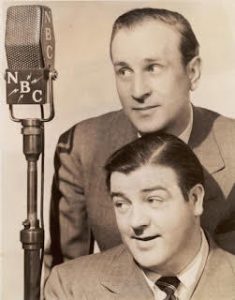 The date was November 4, 1943. Lou Costello was rehearsing at the studios of NBC with the cast and crew, including Bud Abbott, Mel Blanc, Ken Niles and the beautiful Lana Turner, when an emissary of NBC walked in and gave Costello the shocking news that his one-year-old son had drowned at their Van Nuys home. Lou Costello, Jr., nicknamed “Butch,” escaped his playpen, crawled to the swimming pool and fell in. Costello immediately sped from the studio to his home while a pulmotor squad worked futiley to bring back a spark of life to the youngster.
The date was November 4, 1943. Lou Costello was rehearsing at the studios of NBC with the cast and crew, including Bud Abbott, Mel Blanc, Ken Niles and the beautiful Lana Turner, when an emissary of NBC walked in and gave Costello the shocking news that his one-year-old son had drowned at their Van Nuys home. Lou Costello, Jr., nicknamed “Butch,” escaped his playpen, crawled to the swimming pool and fell in. Costello immediately sped from the studio to his home while a pulmotor squad worked futiley to bring back a spark of life to the youngster.
As Costello later recalled in 1954: “Racing into the yard, [my wife] ran to the swimming pool and found the child floating face-down in water a foot and one-half deep. She pulled him from the water and screamed for help.” Neighbors rushed over when they heard the screams and firefighters and medics worked over the boy for more than an hour before Dr. Vincent Kovner pronounced him dead. The baby drowned two days shy of his first birthday.
Driving home from the studio Costello was in denial, convinced that his son was still alive, because he was playing with his baby boy only hours prior. He even told the infant, nicknamed “Butch,” that he would hear his father over the radio speaker that evening. The comedian arrived at his home just as the firefighters were leaving, and discovered the news was true.
Meanwhile, at the studio, producer Martin Gosch and Costello’s partner, Bud Abbott, started making calls for a substitute. Everyone, cast and crew, understood that Costello could not bear up under such grief and go through with a slapstick comedy show. Contact was made with Mickey Rooney, who was on a golf course at the time. After learning the news Rooney tossed aside the clubs, sped to his car and raced to the NBC studio, under the impression that the broadcast time was 5:30 instead of 7:00. He arrived shortly after five and began looking over the script. Even when Costello arrived at the studio, reportedly 25 minutes before airtime, Rooney took a chair with other members of the cast and followed every line in the script, sitting on standby in case Costello needed to be replaced. (During the afternoon Bob Hope, Jimmy Durante and Red Skelton heard the sad news and offered to take over for Costello.)
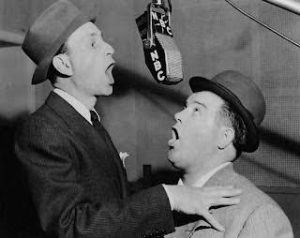 In the tradition of the theatre, “the show must go on,” was deeply ingrained in Costello through his long years in show business, and most rationalized that was the motivation running through his mind. Even in his great grief he must have steeled himself against quitting, as the spirit of the trouper would call it. It was less than an hour before the Camel sign-in when Bud Abbott was called to the phone. It was Costello, telling him he would be there to go through with the show. He arrived at the studio a half-hour later and went through a final reading of his script. When Ken Niles signed in the show, Costello was in front of the mike, smoking a cigar and fidgeting with his script to contain his heartbreak.
In the tradition of the theatre, “the show must go on,” was deeply ingrained in Costello through his long years in show business, and most rationalized that was the motivation running through his mind. Even in his great grief he must have steeled himself against quitting, as the spirit of the trouper would call it. It was less than an hour before the Camel sign-in when Bud Abbott was called to the phone. It was Costello, telling him he would be there to go through with the show. He arrived at the studio a half-hour later and went through a final reading of his script. When Ken Niles signed in the show, Costello was in front of the mike, smoking a cigar and fidgeting with his script to contain his heartbreak.
None in the studio audience that overflowed onto the stage was aware of what Costello was going through. He gave no outward evidence of his great loss, ad-libbing quips and carrying on in the same old Costello way. The crowd howled at his gags, but as he read the last line and tossed his script to a WAVE in the front row, Abbott brought a hush to what had been a bedlam. Lou Costello broke down with tears moments before the closing commercial and supposedly rushed off the stage.
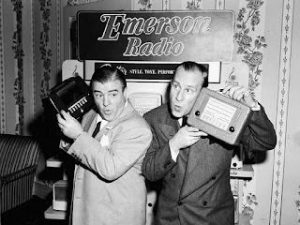 Following the announcer’s closing commercial, Bud Abbott stepped up to the mike to explain to the audience: “Ladies and gentlemen. Now that our program is over and we have done our best to entertain you, I would like take a moment to pay tribute to my best friend and to a man who has more courage than I have ever seen displayed in the theater. Tonight the old expression ‘The show must go on’ was brought home to all of us on this program. More clearly than ever before. Just a short time before our broadcast started, Lou Costello was told that his baby, one year old tomorrow, had died. In the face of the greatest tragedy which can come to any man, Lou Costello went on tonight so that you, the radio audience, would not be disappointed. There is nothing more that I can say except that I know you, all of you, [will] join me in expressing our deepest sympathy to a great trouper.” Ken Niles then signed off with network identification, 40 seconds overtime.
Following the announcer’s closing commercial, Bud Abbott stepped up to the mike to explain to the audience: “Ladies and gentlemen. Now that our program is over and we have done our best to entertain you, I would like take a moment to pay tribute to my best friend and to a man who has more courage than I have ever seen displayed in the theater. Tonight the old expression ‘The show must go on’ was brought home to all of us on this program. More clearly than ever before. Just a short time before our broadcast started, Lou Costello was told that his baby, one year old tomorrow, had died. In the face of the greatest tragedy which can come to any man, Lou Costello went on tonight so that you, the radio audience, would not be disappointed. There is nothing more that I can say except that I know you, all of you, [will] join me in expressing our deepest sympathy to a great trouper.” Ken Niles then signed off with network identification, 40 seconds overtime.
If Bud Abbott had not apprised the audience of the tragedy that befell his partner three hours before broadcast, it is doubtful whether the average radio listener would have even suspected that there had been anything amiss about the show or its principals. Costello lost his place and ad-libbed a little more often than was his habit. What the nationwide audience was not aware was the sobs that were audible through the audience as the people left the auditorium following a three-minute silent tribute. Asked if Costello at any time had shown signs of cracking, Gosch replied to a reporter, “It was the greatest display of courage I’ve ever seen. Lou took it like the great trouper he is.” At one point in the script where Costello read, “I feel sad today,” there were dewy eyes on the stage. He closed it quickly with “I broke up with my girl today.” A less stoic performer would have asked for other lines.
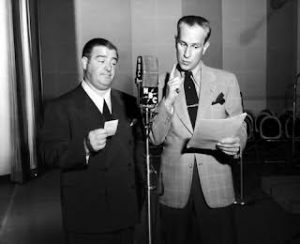 It was the second misfortune to overtake that particular broadcast. The day before the broadcast, Veronica Lake, who had been booked as guest star, had to cancel on account of illness. Lana Turner was substituted. The actress, unable to suppress her own grief over Costello’s loss, read her lines woodenly and hardly above a whisper. In the audience were 25 convalescents from rheumatic fever with their nurses, brought there from the naval hospital at Corona as special guests of Lou Costello. He insisted that the party he had planned for them after the show be carried through, even though he could not attend.
It was the second misfortune to overtake that particular broadcast. The day before the broadcast, Veronica Lake, who had been booked as guest star, had to cancel on account of illness. Lana Turner was substituted. The actress, unable to suppress her own grief over Costello’s loss, read her lines woodenly and hardly above a whisper. In the audience were 25 convalescents from rheumatic fever with their nurses, brought there from the naval hospital at Corona as special guests of Lou Costello. He insisted that the party he had planned for them after the show be carried through, even though he could not attend.
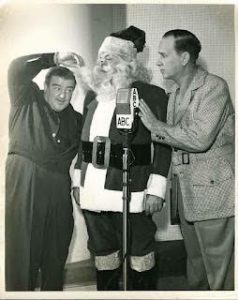 Whether Costello, under the circumstances, should have appeared on the radio broadcast is a moot point. The cast went through the entire script but once and there was no opportunity for a dress rehearsal or final timing. For years a recording of the November 4, 1943, broadcast has been sought after by fans of Bud Abbott and Lou Costello, not widely available to collectors for decades. Of recent, transcription discs were found and that very recording is now making the rounds among collectors. Some might consider the recording morbid but nothing could be further from the truth. Only at the close of the broadcast when Bud Abbott delivers his closing speech does it become apparent that the broadcast was monumental – now historical.
Whether Costello, under the circumstances, should have appeared on the radio broadcast is a moot point. The cast went through the entire script but once and there was no opportunity for a dress rehearsal or final timing. For years a recording of the November 4, 1943, broadcast has been sought after by fans of Bud Abbott and Lou Costello, not widely available to collectors for decades. Of recent, transcription discs were found and that very recording is now making the rounds among collectors. Some might consider the recording morbid but nothing could be further from the truth. Only at the close of the broadcast when Bud Abbott delivers his closing speech does it become apparent that the broadcast was monumental – now historical.
I have often said that collecting and listening to old-time radio is only a tip of the iceberg. Reading up on the history of vintage radio programs can — many times — be more fascinating than the recordings themselves. This particular Abbott and Costello broadcast is no exception.
Listening to the recording today I pose a few theories: At the close of the broadcast, when Bud Abbott steps out to address the audience, you can hear a reaction from those in attendance during the second sentence… before he even mentions the death of Costello’s little son. I wonder if, when Abbott stepped out to address the audience, that was the moment Costello broke down and had to walk off the stage — not after he concluded his final line. Else, why would the audience react at that moment? What would they have been reacting over?
Regarding the reason why Costello wanted to perform during a time of grievance, the comedian was off the air for nine months as a result of rheumatic fever (hence why he set up a party after the broadcast for rheumatic fever victims). It may be possible, because this was the first broadcast of the season and the first broadcast since he was back to health, that he felt a necessity to commit to the radio mike. Costello however, many years later, recalled bouncing his little boy on his knee earlier in the day and telling Butch that he would hear his father on the radio… and wanted to keep that promise.
Hollywood 360 Schedule
12/4/21
The Abbott & Costello Show 12/23/48 Christmas Show
Grand Central Station 12/24/49 Miracle for Christmas
The Red Skelton Show 12/25/49 Christmas Show
Let George Do It 12/25/50 Santa Clause in Glass
The Phil Harris & Alice Faye Show 12/26/48 No Presents from Rexall
12/11/21
The Falcon 12/24/50 The Case of the Unwelcome Christmas Present
The Jack Benny Program 12/13/53 Box of Dates for Don
Suspense 12/21/58 Out for Christmas
The Jimmy Durante Show 12/24/48 Christmas Show
The Saint 12/24/50 Santa Claus Is No Saint
12/18/21
Life With Luigi 12/20/49 Christmas Show
Favorite Story 12/24/49 A Christmas Carol
The Great Gildersleeve 12/21/41 McGee’s Christmas Present
The Burns & Allen Show 12/22/42 Christmas Show
The Damon Runyon Theatre 5/29/51 Palm Beach Santa Claus
12/25/21
The Jack Benny Program 12/31/44 New Year’s Eve Show
Suspense 12/27/45 Pink Camellias
Gunsmoke 1/10/53 Word of Honor
The Life of Riley 12/27/47 Riley Wants a TV Set for Christmas
The Adv. of Philip Marlowe 4/23/49 The Cloak of Kamehameha
© 2021 Hollywood 360 Newsletter. The articles in the Hollywood 360 Newsletter are copyrighted and held by their respective authors.

